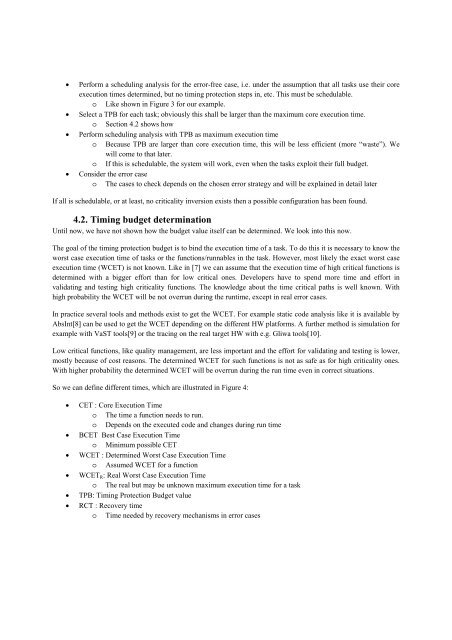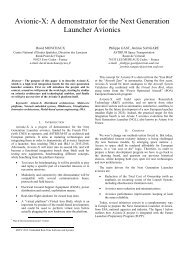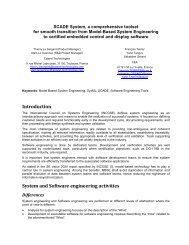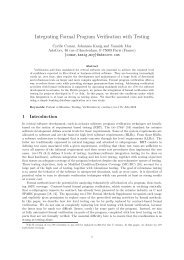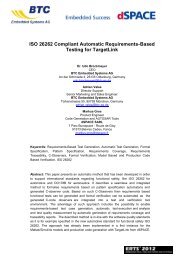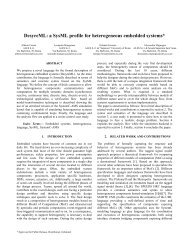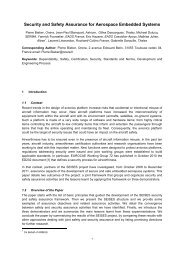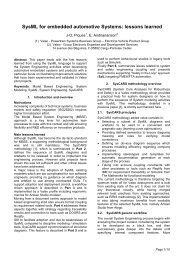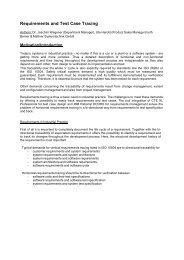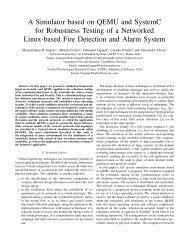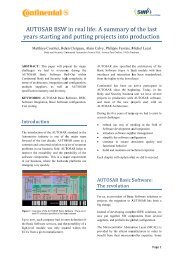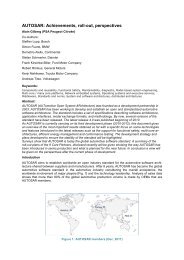Applying the AUTOSAR timing protection to build safe and efficient ...
Applying the AUTOSAR timing protection to build safe and efficient ...
Applying the AUTOSAR timing protection to build safe and efficient ...
Create successful ePaper yourself
Turn your PDF publications into a flip-book with our unique Google optimized e-Paper software.
Perform a scheduling analysis for <strong>the</strong> error-free case, i.e. under <strong>the</strong> assumption that all tasks use <strong>the</strong>ir core<br />
execution times determined, but no <strong>timing</strong> <strong>protection</strong> steps in, etc. This must be schedulable.<br />
o Like shown in Figure 3 for our example.<br />
Select a TPB for each task; obviously this shall be larger than <strong>the</strong> maximum core execution time.<br />
o Section 4.2 shows how<br />
Perform scheduling analysis with TPB as maximum execution time<br />
o Because TPB are larger than core execution time, this will be less <strong>efficient</strong> (more “waste”). We<br />
will come <strong>to</strong> that later.<br />
o If this is schedulable, <strong>the</strong> system will work, even when <strong>the</strong> tasks exploit <strong>the</strong>ir full budget.<br />
Consider <strong>the</strong> error case<br />
o The cases <strong>to</strong> check depends on <strong>the</strong> chosen error strategy <strong>and</strong> will be explained in detail later<br />
If all is schedulable, or at least, no criticality inversion exists <strong>the</strong>n a possible configuration has been found.<br />
4.2. Timing budget determination<br />
Until now, we have not shown how <strong>the</strong> budget value itself can be determined. We look in<strong>to</strong> this now.<br />
The goal of <strong>the</strong> <strong>timing</strong> <strong>protection</strong> budget is <strong>to</strong> bind <strong>the</strong> execution time of a task. To do this it is necessary <strong>to</strong> know <strong>the</strong><br />
worst case execution time of tasks or <strong>the</strong> functions/runnables in <strong>the</strong> task. However, most likely <strong>the</strong> exact worst case<br />
execution time (WCET) is not known. Like in [7] we can assume that <strong>the</strong> execution time of high critical functions is<br />
determined with a bigger effort than for low critical ones. Developers have <strong>to</strong> spend more time <strong>and</strong> effort in<br />
validating <strong>and</strong> testing high criticality functions. The knowledge about <strong>the</strong> time critical paths is well known. With<br />
high probability <strong>the</strong> WCET will be not overrun during <strong>the</strong> runtime, except in real error cases.<br />
In practice several <strong>to</strong>ols <strong>and</strong> methods exist <strong>to</strong> get <strong>the</strong> WCET. For example static code analysis like it is available by<br />
AbsInt[8] can be used <strong>to</strong> get <strong>the</strong> WCET depending on <strong>the</strong> different HW platforms. A fur<strong>the</strong>r method is simulation for<br />
example with VaST <strong>to</strong>ols[9] or <strong>the</strong> tracing on <strong>the</strong> real target HW with e.g. Gliwa <strong>to</strong>ols[10].<br />
Low critical functions, like quality management, are less important <strong>and</strong> <strong>the</strong> effort for validating <strong>and</strong> testing is lower,<br />
mostly because of cost reasons. The determined WCET for such functions is not as <strong>safe</strong> as for high criticality ones.<br />
With higher probability <strong>the</strong> determined WCET will be overrun during <strong>the</strong> run time even in correct situations.<br />
So we can define different times, which are illustrated in Figure 4:<br />
<br />
<br />
<br />
<br />
<br />
<br />
CET : Core Execution Time<br />
o The time a function needs <strong>to</strong> run.<br />
o Depends on <strong>the</strong> executed code <strong>and</strong> changes during run time<br />
BCET Best Case Execution Time<br />
o Minimum possible CET<br />
WCET : Determined Worst Case Execution Time<br />
o Assumed WCET for a function<br />
WCET R : Real Worst Case Execution Time<br />
o The real but may be unknown maximum execution time for a task<br />
TPB: Timing Protection Budget value<br />
RCT : Recovery time<br />
o Time needed by recovery mechanisms in error cases


